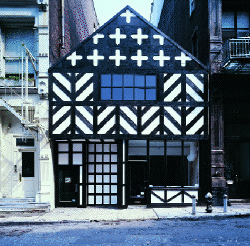Richard Woods
Deitch Projects, New York, USA
Deitch Projects, New York, USA

For the keen-eyed design professionals of Changing Rooms and its American incarnation Trading Spaces, there's nothing a fresh coat of paint can't fix. Richard Woods has likened his work to this popular home-makeover show, in which terms such as 'focal point' and 'conversation area' are introduced, lilies strategically placed and wobbly Ikea shelving units disguised with stagey colour schemes. In his latest project, Super Tudor (2002), Woods shows that a little clever surface manipulation can go a long way.
Woods has radically transformed the gallery interior and, in an equally ambitious gesture, its exterior. The latter is an arresting mock-Tudor façade, an English vernacular that also, for many New Yorkers, suggests the spruced-up strip malls of New England suburbs. Rubbing shoulders with renovated loft buildings, the quaint gabled stucco is an effective poke at Soho's second-wave colonization by chain stores and luxury flagships.
Inside the gallery Woods leaves no surface untouched. The main room is covered with a large-scale block print of parrots, resembling oversize stencil work, in black on white. The walls are hung salon-style with Woods' Pop take on marquetry painting: black-painted slivers of MDF glued to bright yellow canvas-covered wood panels. Most depict stock country-house images - a trout, a thrush, a bouquet of poppies, an exotic native. A few portray decorative frames without content. A floor block-printed with a mock parquetry herringbone pattern, black faux wood-grain on a sky blue ground, runs throughout the gallery. The effect is electric and uniformly cartoonish, like stepping into a Patrick Caulfield painting.
In the centre of the room ersatz Neoclassical garden sculptures sit in plastic basins, spewing water from navels, neck stumps and other unlikely apertures via a crude system of pumps and plastic tubing. These makeshift fountains are admittedly lightweight, but surrounding touches reveal a curious mix of the slapdash and the deliberate: several basins still display their store labels, while the antique wooden tables beneath have been painted over in various shades of brown. Many of the marquetry paintings are cobbled together from multiple panels in true bricoleur fashion, their edges out of alignment.
Like D. J. Simpson, Woods is obviously handy with a router; his super-sized wood-grain, for example, was created by carving and printing from five different blocks in a tautological tour de force. The joke, of course, is that true wood-grain never repeats itself. Woods has used similar exaggerated patterns to good effect in earlier exhibitions, including a group show ('Epilogue', 2000) at the historic Tabley House in Cheshire. In Super Tudor he fuses the masculine, working-class craft of woodworking with a refined but equally intense domesticity: it's as if Martha Stewart had a love child with Bob Vila of This Old House.
Woods has commented that his favourite work of art is Pollock's One: Number 31 (1950); this fact is not so surprising given both artists' preoccupation with surface, pattern and the floor. Perhaps in homage to Pollock, Woods has made a series of 'Drippy Paint Drawings' (2002) which hang in the gallery's side room against a background of red and white cockatoo prints. These enamel-paint renderings of famous classical sculptures are executed in a wobbly, amateurish line. Each image bears a number and a faux naive descriptive subtitle: Drippy Paint Drawing # 4 (Two Men and a Woman) is clearly modelled on Giambologna's Rape of the Sabine Women (1583) while the inspiration for # 12 (Dancing and Waving) and # 31 (Drinking and Pouring) is less clear. Hinting at Grand Tour pretensions, the drawings echo Woods' irreverent fountains but otherwise don't add much to the décor.
Super Tudor works well enough as an absurd twist on the cult of home improvement, but it also sends up the current cross-pollination of art, architecture and interior design. Liam Gillick turns utopian Modernism into office space. Jorge Pardo's tiled renovation of the Dia Center lobby is stunning, but as slick as anything in Wallpaper*. Super Tudor is the art installation as show house, with every gallery surface reworked into a dramatization of surface itself.
Woods' transformations are most effective when selectively applied. In a solo exhibition at London's Zwemmer Gallery in 2000 a wood-grain floor print (on its own) reintroduced the creaky Soho building's naturally rough edges into the refurbished gallery space. For this show Woods has crafted an oddly cohesive environment from seemingly disparate components. Without a counterpoint the interior falls prey to a Changing Rooms aesthetic of total, stifling co-ordination. Apparently, with his craftsman's sensibility and his DIY spirit, Woods can't help pulling it all together.















